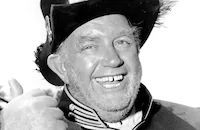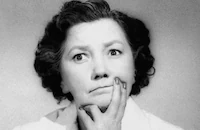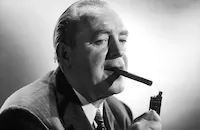The Phynx

Brief Synopsis
Cast & Crew
Lee H. Katzin
A. Michael Miller
Ray Chippeway
Dennis Larden
Lonny Stevens
Lou Antonio
Photos & Videos
Film Details
Technical Specs

Synopsis
The U. S. Super Secret Agency (SSA) is disturbed by the kidnaping of a number of American show business people by Communist Albania. SSA Agent Corrigan tries to penetrate Albania but is blocked by Albanian Army Chief Rostinov. Number One holds a secret meeting to decide how SSA can solve the problem, and Wee Johnny Wilson of the Underage Underground suggests that they consult MOTHA (Mechanical Oracle That Helps Americans). The computer responds with a scheme to form a rock group, "The Phynx", to tour Albania. An athlete, a campus militant, a Negro model, and an American Indian form the group; and with the help of record producer Philbaby, The Phynx record an album that is pushed to fame by SSA force tactics. After a farewell orgy provided by the government, The Phynx are sent to London where a double agent (played by Martha Raye) reveals that maps giving directions to the secret castle in Albania where the prisoners are confined are tattooed on the bellies of her three daughters, living respectively in London, Copenhagen, and Rome. Finally arriving at the castle, the group is greeted by Marshal Markevitch and his American wife (played by Joan Blondell), for whose sake Markevitch has kidnaped her former colleagues. A loud rock guitar session welcomes The Phynx, the walls of the castle crumble in the resulting vibrations, and the American prisoners escape.

Director
Lee H. Katzin
Cast
A. Michael Miller
Ray Chippeway
Dennis Larden
Lonny Stevens
Lou Antonio
Mike Kellin

Michael Ansara

George Tobias

Joan Blondell
Larry Hankin
Teddy Eccles
Ultra Violet
Pat Mccormick
Joseph Gazal
Bob Williams
Barbara Noonan
Rich Little
Sue Bernard
Ann Morell
Sherry Miles

Patty Andrews
Rona Barrett

Edgar Bergen

Busby Berkeley
James Brown

Dick Clark

Xavier Cugat
Cass Daley

Andy Devine

Fritz Feld

Leo Gorcey

Huntz Hall
John Hart

Louis Hayward
George Jessel

Ruby Keeler

Patsy Kelly

Dorothy Lamour
Joe Louis
Guy Lombardo
Trini Lopez

Marilyn Maxwell

Butterfly Mcqueen

Pat O'brien

Maureen O'sullivan

Richard Pryor

Martha Raye
Harold Sakata
Col. Harlan Sanders
Jay Silverheels
Ed Sullivan

Rudy Vallee

Clint Walker

Johnny Weissmuller
Crew
Bob Booker
Bob Booker
Sonny Burke
Dann Cahn
Bruce Chevillat
Leon Chooluck
Stan Cornyn
Don Feld
George Foster
George Foster
Michel Hugo
Ralph S. Hurst
Stan Jolley
Jean Kean
Jerry Leiber
Les Sheldon
Mike Stoller
Dan Wallin
Westheimer Co.

Photo Collections
Film Details
Technical Specs

Articles
The Phynx
No doubt there are a number of film fans who are "completists" when it comes to some of their favorite actors or actresses, making it their mission to see every film in that star's filmography. Such an approach can be perilous--not just from being exposed to a rotten movie or two, but because certain titles are difficult or impossible to see. So, pity the hardcore fan of Ruby Keeler or Maureen O'Sullivan or Rudy Vallee or Pat O'Brien or Dorothy Lamour or any of the other Golden Age stars who appear in the Warner Bros.-Seven Arts film The Phynx (1970); not only is it the strangest film on any those participant's filmography--until recently it had also been a virtually "lost" movie for decades.
Recounting the set-up of The Phynx only hints at the delirium reached in its 81-minute running time. In a pre-credits sequence, a spy we later learn is named Corrigan (Lou Antonio) is foiled in every outlandish attempt to break into the Iron Curtain country of Albania. The first words heard are Corrigan's voiceover calling his foes "dirty, lousy Commie" and "slimy, sleazy savage." The animated opening titles continue the theme as cartoon Corrigan makes further attempts by sewer, skateboard, and circus cannon. Back in live-action, Corrigan ducks into an International House of Pancakes restroom, which doubles as the office of his boss at Super Secret Agents of America, Bogey (Mike Kellin doing a not-very-good Humphrey Bogart impression). Bogey berates Corrigan's efforts and brings in the agency's top man, a suit wearing a cardboard box with a face drawn on it (voice of Rich Little, who is doing something between his Richard Nixon impression and his Jimmy Stewart impression). They meet in a large hall with all of their field spies, who are grouped according to their disguises (Madison Avenue executives, Black Panthers, Cub Scouts, Ku Klux Klansmen, Chinese laundry workers, hookers, etc.) to detail their mission and solicit suggestions. Via slides and newsreel footage, it is explained that "important world figures" have disappeared into Albania and the SSA are tasked to get them out past the watchful eye of the Albanian Army's Col. Rostinov (Michael Ansara). Wee Johnny Wilson (Ted Eccles) of the Underage Underground suggests that the humanoid SSA super-computer M.O.T.H.A. (Mechanical Oracle That Helps Americans) be consulted, and the solution is to (what else?) form a pop musical group and get invited to Albania. Johnny sees the sense in this, saying "national boundries cannot separate teeny freaks--do the Beatles need passports?"
The plot of The Phynx is weighed down with needless detail and nonsensical asides throughout, which can probably be chalked up to the fact that screenwriter Stan Cornyn had no previous (or subsequent) film experience--he was an executive with the Creative Services department of Warner Bros. Records. Following the surprise smash success of the Columbia Pictures release of Easy Rider in 1969, most of the big studios tried to tap into the "youth culture" market, so it must have made sense for Warner Bros. to look to their Records division for input and inspiration. In fact, the most coherent and genuinely amusing sequences in The Phynx deal with the creation and promotion of the rock band. M.O.T.H.A. comes up with the band name (a nod to the early-60s youth-oriented "custom culture" icon Rat Fink, created by Ed "Big Daddy" Roth), and chooses the four diverse young men (Michael A. Miller, Ray Chippeway, Dennis Larden, Lonnie Stevens) who are shanghaied from their separate lives and thrown together in a secluded SSA training area. Here, in the first major round of offbeat celebrity cameos for which The Phynx is known, the four are drilled in combat techniques by Clint Walker, trained in "hipness" by Richard Pryor, given music lessons by Trini Lopez, and line up for a final once-over in youth appeal by Dick Clark! To produce the debut album, a hot-shot producer named "Philbaby" (played cheekily by Larry Hankin and clearly based on Phil Spector) is flown in by helicopter (as in suspended by cable from the bottom of a helicopter in one of the film's more memorable sight gags). The Phynx album becomes a hit, partially thanks to an aggressive round of nefarious promotion which includes holding a gun on Ed Sullivan while he introduces the band on his variety show!
By the midpoint of The Phynx, the film has fallen into tiresome and familiar spy movie spoof territory, and the finale is an underwhelming set-piece featuring a veritable orgy of gratuitous celebrity cameos. These cameos are the picture's main claim to fame and are by turns inconsistent (Joan Blondell appears, but she is playing a character in the film instead of playing herself as her fellow former Warner Bros. contract player Ruby Keeler does), touching (Johnny Weissmuller and Maureen O'Sullivan share some final scenes together), puzzling (why is Colonel Sanders here?), and downright surreal (Butterfly McQueen came out of retirement to trade quips with Rudy Vallee while hiding in a turnip cart). While Otto Preminger's equally bizarre Skidoo (1968) gave his eclectic cast some interesting roles and a lot of quirky action, The Phynx is content to have its cast of cameos walk in single file and sit virtually motionless in chairs. (Some of the other familiar faces on view include Patty Andrews, Busby Berkeley, Xavier Cugat, Fritz Feld, Joe Louis, Marilyn Maxwell, Leo Gorcey, Louis Hayward, Patsy Kelly, Guy Lombardo, Edgar Bergen and Charlie McCarthy, Andy Devine, Huntz Hall and George Jessel).
All of the songs for The Phynx were written by the powerhouse team of Jerry Lieber and Mike Stoller. Lieber & Stoller's rock credentials were unimpeachable and they knew their way around a movie soundtrack, having written the amazing song score for the Elvis Presley showcase Jailhouse Rock (1957). Their songs for The Phynx are good but remarkably unmemorable and seem to cut across every imaginable outdated pop music genre instead of concentrating on 1970-era rock.
The animated titles for The Phynx were created by the last vestige of the famous Looney Tunes Warner Bros. Cartoon Department, by animator Bill Hendricks' unit that had most recently made the Cool Cat theatrical cartoons of the late 1960s.
By some accounts The Phynx went unreleased or was immediately shelved by Warner Bros.-Seven Arts, but it seems to have had at least one well-publicized premiere screening. Contemporary newspaper ads exist that show that the studio at least generated ad art (a cartoon Uncle Sam figure against a brick wall, shielding his face with a poster or album cover of The Phynx), and a tagline ("Of all the American heroes who served their country in its hour of need--only one had a great rock sound..."). A "World Premiere" screening was held in Indianapolis, and the theatre even publicized a local radio-sponsored "Rock & Roll 'Phynx' Contest" with a live performance of the winning band. Evidence of screenings beyond this premiere does not seem to exist and movie posters and other advertising material was not printed in any quantities, so the film was effectively shelved following the premiere. It had a few television showings in the early 1970s but disappeared from view for years, and in the home video era was only available in the form of illegal bootleg tapes--a cult item sought out by fans of "bad cinema." The Phynx was not officially released until Warner Home Archive offered it as a print-on-demand DVD in 2012.
The year following The Phynx, Ruby Keeler and Busby Berkeley enjoyed a much more successful collaboration, a highly-praised Broadway revival of No No Nanette.
Producer: Bob Booker, George Foster
Director: Lee H. Katzin
Screenplay: Stan Cornyn
Cinematography: Michel Hugo
Art Direction: Stan Jolley
Songs: Jerry Leiber and Mike Stoller
Music: Jimmie Haskell
Film Editing: Dan Cahn
Cast: Michael A. Miller, Ray Chippeway, Dennis Larden, Lonnie Stevens (The Phynx), Lou Antonio (Corrigan), Mike Kellin (Bogey), Michael Ansara (Col. Rostinov), George Tobias (Markevitch), Joan Blondell (Ruby), Martha Raye (Foxy), Larry Hankin (Philbaby), Ultra Violet (Felice), Rich Little (Voice in the Box), Patty Andrews, Busby Berkeley, Xavier Cugat, Fritz Feld, Ruby Keeler, Joe Louis, Marilyn Maxwell, Maureen O'Sullivan, Ed Sullivan, Rona Barrett, James Brown, Leo Gorcey, Louis Hayward, Patsy Kelly, Guy Lombardo, Butterfly McQueen, Richard Pryor, Colonel (Harland) Sanders, Rudy Vallee, Johnny Weissmuller, Edgar Bergen (and Charlie McCarthy), Dick Clark, Andy Devine, Huntz Hall, George Jessel, Dorothy Lamour, Trini Lopez, Pat O'Brien (Themselves)
C-81m.
by John M. Miller

The Phynx
Richard Pryor (1940-2005)
He was born Richard Thomas Pryor III on December 1, 1940 in Peoria, Illinois. By all accounts, his childhood was a difficult one. His mother was a prostitute and his grandmother ran a brothel. His father was rarely around and when he was, he would physically abuse him. From a young age, Pryor knew that humor was his weapon of choice to cut through all the swath he came across and would confront in his life.
After high school, he enlisted in the Army for a two-year stint (1958-60). When he was discharged (honorably!) he concentrated on stand-up comedy and worked in a series of nightclubs before relocating to New York City in 1963. In 1964, he made his television debut when he was given a slot on the variety program On Broadway Tonight. His routine, though hardly the groundbreaking material we would witness in later years, was very well received, and in the late '60s Pryor found more television work: Toast of the Town, The Wild Wild West, The Mod Squad ; and was cast in a two movies: The Busy Body (1967) with Sid Caesar; and Wild in the Streets (1968) a cartoonish political fantasy about the internment of all American citizens over 30.
Pryor's career really didn't ignite until the '70s. His stand up act became raunchier and more politically motivated as he touched on issued of race, failed relationships, drug addiction, and street crimes. His movie roles became far more captivating in the process: the piano man in Lady Sings the Blues (1972); as a wise-talking hustler in a pair of slick urban thrillers: The Mack (1973) and Uptown Saturday Night (1974); the gregarious Daddy Rich in Car Wash; his first pairing with Gene Wilder as Grover, the car thief who helps stops a runaway train in his first real box office smash Silver Streak (both 1976); and for many critics, his finest dramatic performance as a factory worker on the edge of depression in Paul Schrader's excellent working class drama Blue Collar (1978).
On a personal level, his drug dependency problem worsened, and on June 9, 1980, near tragedy struck when he caught fire while free-basing cocaine. Pryor later admitted that the incident, was, in fact, a suicide attempt, and that his management company created the lie for the press in hopes of protecting him. Fortunately, Pryor had three films in the can that all achieved some level of financial success soon after his setback: another pairing with Gene Wilder in the prison comedy Stir Crazy (1980); a blisteringly funny cameo as God who flips off Andy Kaufman in the warped religious satire In God We Tru$t (1980); an a ex-con helping a social worker (Cicely Tyson) with her foster charges in Bustin' Loose (1981). He capped his recovery with Live on the Sunset Strip (1982), a first-rate documentation of the comic's genius performed in front of a raucous live audience.
In 1983, Pryor signed a $40 million, five-year contract with Columbia Pictures. For many fans and critics, this was the beginning of his downslide. His next few films: The Toy, Superman III (both 1983), and Brewster's Millions (1985) were just tiresome, mediocre comedies. Jo Jo Dancer, Your Life is Calling (1986), was his only attempt at producing, directing, and acting, and the film, which was an ambitious autobiographical account of a his life and career, was a box-office disappointment. He spent the remainder of the '80s in middling fare: Condition Critical (1987), Moving; a third pairing with Gene Wilder in See No Evil, Hear No Evil; and his only teaming with Eddie Murphy in Harlem Nights (1989).
In 1986, Pryor was diagnosed with multiple sclerosis, a degenerative disease of the nervous system that curtailed both his personal appearances and his gift for physical comedy in his latter films. By the '90s, little was seen of Pryor, but in 1995, he made a courageous comeback on television when he guest starred on Chicago Hope as an embittered multiple sclerosis patient. His performance earned him an Emmy nomination and he was cast in a few more films: Mad Dog Time (1996), Lost Highway (1997), but his physical ailments prohibited him from performing on a regular basis. In 1998, The John F. Kennedy Center for the Performing Arts in Washington gave Pryor the first Mark Twain Prize for humor. It was fitting tribute for a man who had given so much honesty and innovation in the field of comedy. Pryor is survived by his wife, Jennifer Lee; his sons Richard and Steven; and daughters Elizabeth, Rain and Renee.
by Michael T. Toole
Richard Pryor (1940-2005)
Quotes
Trivia
Miscellaneous Notes
Released in United States 1970
Released in United States 1970













